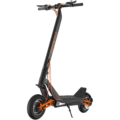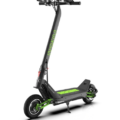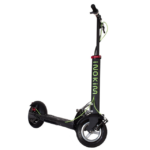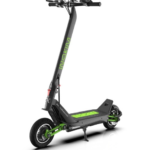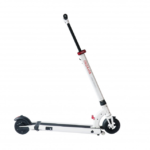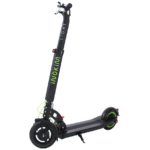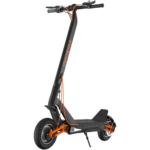- Home
- Scooters
- Electric Scooters
- INOKIM Quick 4
INOKIM Quick 4
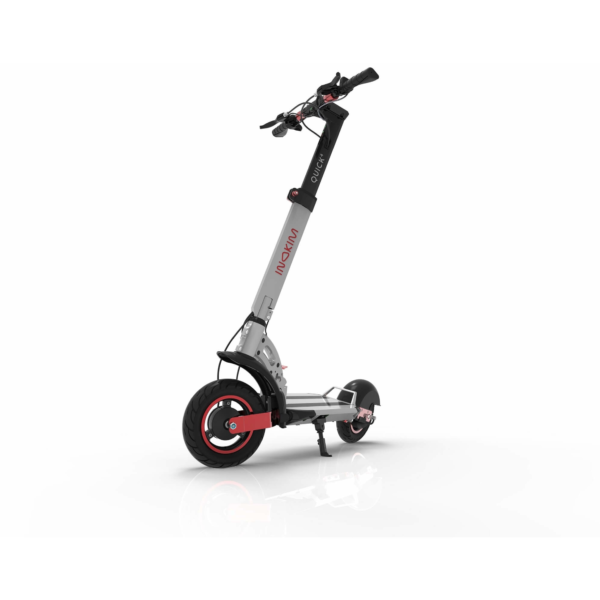

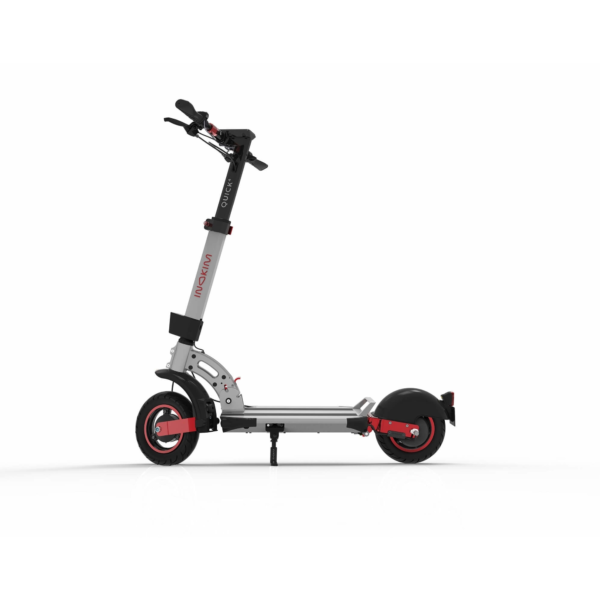
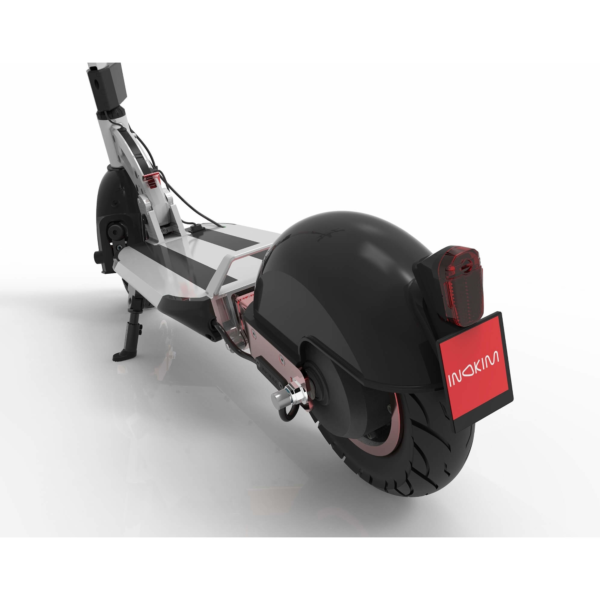
- Battery Range: 28–37 miles (45–60 km)
- Top Speed: 25 mph (40 km/h)
- Motor Power: 600 W
- Weight Capacity: 265 lb (120 kg)
- Charging Time: ~8–12 h
- Scooter Weight: 47.0 lb (21.3 kg)
PROS
- 10″ pneumatic tires for stability
- Front & rear suspension
- 600 W rear motor with solid torque
- Dual drum brakes
- Large 52 V battery options
CONS
- Heavier than entry-level models
- No Bluetooth app
- IP rating not specified
- Drum brakes lack hydraulic power

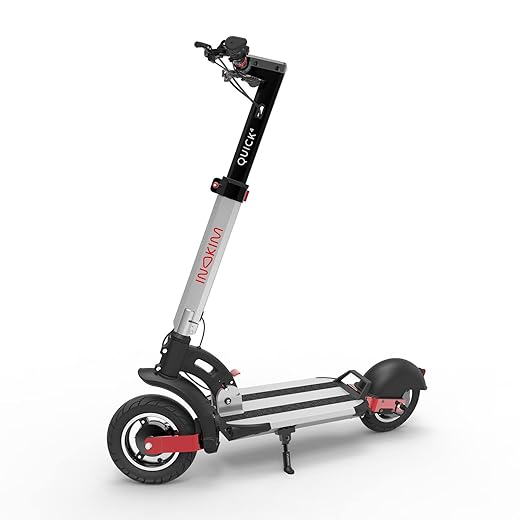
Key Takeaways
- The INOKIM Quick 4 is a single-motor commuter scooter designed for smooth and stable rides.
- It offers two trims: Hero and Super, with variations in battery capacity for longer rides.
- Key features include a 600W rear hub motor, dual drum brakes, and a range of 30-40 miles depending on the model and conditions.
- The design prioritizes comfort and usability, making it ideal for daily commuters and heavier riders.
- It has an IPX4 rating for water resistance, highlighting suitability for light rain and daily use.
Table of contents
- What Is the INOKIM Quick 4?
- How the INOKIM Quick 4 Works
- Key Specifications
- Design & Build Quality
- Performance Fundamentals
- Battery, Range & Efficiency
- Ride Quality & Comfort
- Braking & Safety Features
- Portability & Daily Usability
- Maintenance & Care
- Weather & Seasonal Considerations
- INOKIM Quick 4 vs Alternatives
- Who the INOKIM Quick 4 Is (and Isn’t) For
- FAQs
- Glossary
The INOKIM Quick 4 is a polished single-motor commuter that feels steady and easy. It blends usable power, real range, and a tidy fold. It keeps maintenance simple, too. So it suits daily riders who want a calm, confidence-building scooter that still packs some fun. If you want something even lighter from the same maker, take a look at the INOKIM Light 2.
What Is the INOKIM Quick 4?
The INOKIM Quick 4 sits near the top of city-focused single-motor scooters. It runs a stout rear hub motor, quality lithium-ion cells, and a reinforced frame that stays quiet over time. The setup favors balance and control over drag-race launches. You get 10-inch air-filled tires, dual drum brakes, and front and rear suspension. The fold is solid, the cockpit is clean, and the whole package feels sorted.
INOKIM ships two trims: Hero and Super. Both share the same chassis, motor, and brakes. The Super carries a larger battery for longer rides, and the Hero trims a bit of weight. Pick the Super if your route stretches out. Pick the Hero if you carry more or climb stairs often. Either way, the ride character stays the same: smooth, planted, and predictable.
How the INOKIM Quick 4 Works
A brushless hub motor lives in the rear wheel. The controller meters current from the deck-mounted battery to that motor. You press the thumb throttle, and power comes in with a smooth ramp. So starts feel tidy in traffic, and creeping along at walking pace is easy.
The battery uses high-grade cells in a 14-series layout. A battery management system watches voltage, current, and temperature. It protects the pack during charge and discharge. You plug a standard charger into the sealed port, and it fills the pack from low to full in roughly seven hours. The port sits high, so grit and splash are less of a worry.
Braking is simple and consistent. Each wheel has a drum inside a sealed housing. The levers bring in bite early, then build in a linear way. That feel helps you stay straight during hard stops. Lights front and rear keep you visible in low light, and side reflectors add coverage at angles.
Key Specifications
| Category | Item | Value |
|---|---|---|
| General | Model | INOKIM Quick 4 (Hero / Super) |
| Frame material | Aviation-grade aluminum alloy | |
| Water resistance | IPX4 | |
| Max load | 265 lb (120 kg) | |
| Warranty | 12 months | |
| Performance & Power | Motor | 600 W rear hub, brushless |
| Peak output | ~900–1200 W class (trim-dependent) | |
| Top speed (design) | 24.8 mph (40 km/h), region caps may apply | |
| Hill use | Built for city grades around ~7–10% | |
| Battery, Charging & Electrical | Battery (Hero) | 50.4 V, 13 Ah (≈655 Wh) |
| Battery (Super) | 50.4 V, 16 Ah (≈806 Wh) | |
| Charge time | ~7 hours from low | |
| Lighting | Integrated front and rear LEDs | |
| Display | INOKIM LCD, multiple ride modes | |
| Compliance | SGS-tested for UL 2272 | |
| Build & Dimensions | Tire size/type | 10 × 2.5 in pneumatic |
| Suspension | Adjustable front and rear | |
| Brake system | Dual drum, cable-actuated | |
| Scooter weight | 47.4 lb (21.5 kg) | |
| Unfolded size | 44.5 × 22.4 × 47.2 in (113 × 57 × 120 cm) | |
| Folded size | 43.3 × 9.8 × 21.6 in (110 × 25 × 55 cm) | |
| Safety & Control | Drive | Rear-wheel |
| Cockpit | Thumb throttle, clear LCD, mode switch | |
| Reflectors | Side and rear reflectors | |
| Features & Extras | Cruise control | Yes |
| Kickstand | Side kickstand | |
| Portability | Single-action latch with stem hook | |
| Warranty & Compliance | Regional limits | Many places cap speed to 15.5–18.6 mph (25–30 km/h) |
| Certification | UL 2272 (via SGS), IPX4 ingress rating |
Notes: Weight, speed class, battery sizes, brakes, tire type, IP rating, UL status, and dimensions trace back to official materials and long-standing retail listings. So the figures here match what owners see in the real world.
Design & Build Quality
First impression: the INOKIM Quick 4 looks clean and feels tight. The frame uses thick-wall aluminum with neat welds. The deck is long and flat, so your stance feels natural from day one. Grip tape has good bite, and the deck edges have a soft radius that saves shins when you bump them.
The stem resists twist during hard braking. The main latch closes with a firm cam action, and it stays put on rough pavement. The stem hook catches the rear fender for carrying, so the scooter stays closed while you lift. Fasteners are captive where it counts. That helps alignment and makes checks quick.
The cockpit is simple in a good way. A thumb throttle sits on the right beside a compact LCD. You can read speed, mode, and battery bars at a glance. The bell and front brake lever sit on the left. Cables run in a tidy sleeve down the stem, then into the deck where the controller lives low and centered. So the scooter feels planted and stable at speed.
Ten-inch air tires soak up seams and small potholes. Drums in both hubs run quiet and free of grit. Fenders are sturdy for daily use. The rear unit puts up with being the carry hook target day after day. The paint has a satin look that hides small scuffs from racks and walls.
Performance Fundamentals
On flat ground the Quick 4 pulls with calm, steady force. It does not snap forward at zero, and that is intentional. The throttle map eases in power so the rear tire keeps grip on dust or damp spots. Starts in traffic feel controlled, and low-speed maneuvers feel natural.
Cruising is where it shines. The long deck and low battery mass steady the chassis. Steering stays settled at common city speeds, even with crosswind gusts. You can click cruise control on a long path and give your thumb a break. Speed holds tight on level routes, so the ride rhythm feels smooth.
On 7–10% grades the motor keeps climbing with a small drop in pace. Heavier riders may want a short running start on the steepest sections near 10%. The controller limits current to protect the pack and motor, then sheds heat into the deck. So hill repeats stay within comfort zones for both rider and hardware.
Battery, Range & Efficiency
The pack comes in two flavors. Hero runs 13 Ah. Super runs 16 Ah. Both use a 14-series layout at 50.4 V nominal. The difference shows up in range. Light riders on flat paths often see mid-30s miles on Hero and low-40s on Super at modest pace. Heavier riders and hilly routes trim those figures. That is normal for any scooter.
Conditions matter. Cold weather slows chemistry and reduces range. Headwinds force the motor to draw more to hold speed. Higher tire pressure helps efficiency on smooth pavement, and dropping a few PSI can help comfort on rough patches. Balance those trade-offs based on your route and load.
Want the pack to last? Keep daily charges simple. Top up after rides that end near empty. Try not to leave it parked at 100% for days. For storage, aim near 40–60% state of charge and keep it in a cool, dry room. Then the pack stays healthy for many seasons.
Ride Quality & Comfort
Comfort starts at the tire and suspension. Ten-inch pneumatics shape a nice contact patch and roll over cracks without sharp hits. Front and rear springs add travel and take the edge off speed bumps and tiled paths. The combo keeps the bars calm and your feet planted.
The deck gives you room to stand with one foot forward, one back. That stance helps balance and control. The stem stays composed over broken pavement, so your hands do not buzz after long rides. On fresh asphalt the scooter tracks quietly. On brick and chip-seal, the tires and springs tone down the chatter. Long rides feel relaxed, not jittery.
Hand comfort improves with a light, steady grip. Gloves help in winter. Keep a small bend in knees and elbows and let the scooter move under you. The center of gravity sits low in the deck, which helps cornering feel natural. You can lean in with confidence and roll back on the throttle cleanly.
Braking & Safety Features
Drum brakes fit daily use. They live inside sealed shells, so splash and grit do less harm. Lever travel comes in smooth, then firms up as you add force. Modulation feels easy to read. On wet days, bite stays consistent after puddles, which boosts confidence.
Lights cover day-to-day needs. A front LED helps drivers notice you at dusk. A rear LED marks your position. Add reflective bits to your helmet or jacket for more pop at night. The IPX4 rating means the scooter handles light rain and street splash. Deep puddles, pressure hoses, and heavy downpours remain a bad idea. Charge only in dry spaces.
Local rules vary by region, and many places cap top speed in public areas. You can set a lower limit in the scooter’s menu. Safe habits do more than any spec sheet. Keep both hands on the bars, knees soft over bumps, and eyes up. Check tire pressure weekly. Proper PSI shortens stops and sharpens handling.
Portability & Daily Usability
At 47.4 lb (21.5 kg), the INOKIM Quick 4 lands in the “sturdy but carryable” zone. One flight of stairs is fine with a short pause. The stem locks to the rear catch, so it stays shut while you lift by the stem. The folded shape slides into most trunks and fits well beside a desk.
The charger is compact and stashes in a backpack pocket. The charge port sits high and seals well, so grime has a tougher time getting in. The kickstand holds steady on flat ground and short grass. Curb drops feel controlled with a small lift at the stem. Fenders keep spray down in light rain, which helps if you ride in work clothes.
Security starts with where you park. Bring the scooter inside when possible. If you must leave it outside, lock to a strong fixture and avoid overnight. Many riders add a compact disc lock on quick errands for a second layer. Two varied locks discourage quick grabs.
Maintenance & Care
A short routine keeps the Quick 4 running tight and quiet. Here is a practical schedule you can actually stick to:
- Every ride: Glance at the stem latch and bar clamp. Squeeze both brake levers to confirm bite. Tap the lights and bell.
- Weekly: Check tire pressure. Look for cuts or embedded debris. Wipe the deck, stem, and controls with a damp cloth, then dry.
- Monthly: Inspect brake cables for fray or kinks. Make sure drum arms return smoothly. Check hinge hardware with a hand tool and stop at firm resistance.
- Quarterly: If you feel a side hop, have the wheels checked for true. Add a drop of lube to cable ends. Inspect the charge port cap and replace if cracked.
- Annually: Ask a shop to check bearings, headset preload, and cables. Replace tires if tread is low or sidewalls show cracks.
Keep fasteners snug, not cranked. Replace tubes and tires in pairs if wear is uneven. Store at moderate temperature. After rides that end near empty, plug in. When the light turns green, you can stop. Avoid parking at extreme high or low state of charge for weeks.
Weather & Seasonal Considerations
Rain, heat, and cold all change how any scooter feels. In light rain the rubber still grips and the drums still brake well. Slow down on paint and metal surfaces and keep your line steady through puddles. After a wet ride, dry the scooter and let it breathe in a warm room before charging.
Hot days can stretch range at an easy pace, yet long, hard pulls build heat. Park in the shade during breaks. Avoid leaving the scooter in a hot car. Cold snaps shrink range and stiffen tires. Start with fresh PSI and ride a touch gentler. Gloves and a relaxed grip help with control. Bring the scooter inside after winter rides so it can dry.
Skip deep water, beach sand, and pressure washers. IPX4 means splash resistance, not water play. If a storm hits, cut the ride short and get under cover. Keep charging indoors only. A simple entryway mat and cover make rainy-day storage easy.
INOKIM Quick 4 vs Alternatives
Riders usually compare the Quick 4 with three groups.
- Lightweight commuters (26–35 lb / 12–16 kg): These fold smaller and feel great on stairs. They give up deck space, stability on rough routes, and some brake power. The Quick 4 rides steadier at speed and carries heavier loads with less stress.
- Faster single-motor models: Some push a higher top speed and use stiffer tires or narrower decks. You might gain a few mph and lose comfort or braking feel. The Quick 4 leans into balance and layout quality, so day-to-day rides feel calmer.
- Dual-motor sport commuters: They climb faster and blast up steep hills, and they weigh more. They usually ask for more maintenance, too. If your grades stay under about 10% and you want comfort first, the Quick 4 is a smart pick. If you love hill sprints and do not mind weight, a twin-motor makes sense, like the bigger-suspension INOKIM OX.
Short version: the INOKIM Quick 4 is a calm, sturdy, low-stress city scooter with enough punch for real commuting. No drama, just steady miles.
Who the INOKIM Quick 4 Is (and Isn’t) For
Great for:
- Daily commuters who want smooth control and a strong chassis.
- Students who need a reliable ride between classes.
- Multi-modal travelers who fold, carry, and ride in one trip.
- Heavier riders who want a solid deck and stable handling.
- Night riders who value sealed brakes and steady lights.
Maybe not ideal for:
- Riders who want hard launches and very high top speeds.
- Regular off-road use on rock or deep gravel.
- Routes with long stretches above 12–15% grades.
- People who need a super-light carry under 30 lb.
FAQs
1) How fast is the INOKIM Quick 4?
It targets about 24.8 mph (40 km/h). Some regions cap the legal limit to 25–30 km/h, and you can set a lower limit in the menu.
2) What range can I expect day to day?
Light riders on flat paths often see mid-30s miles on Hero and low-40s on Super at easy pace. Hills, wind, cold, and high speeds trim those numbers.
3) Does it include cruise control?
Yes. It holds speed on long, straight sections so your thumb can rest.
4) What tire pressure should I run?
Many riders like 50–55 PSI on smooth roads. On rough surfaces, dropping a few PSI can help comfort. Then bump it back up for efficiency.
5) How heavy is it and how small does it fold?
It weighs 47.4 lb (21.5 kg). Folded size is about 43.3 × 9.8 × 21.6 in (110 × 25 × 55 cm). That fits many trunks and closets.
6) Is it good for daily hills?
It handles 7–10% grades with a steady pace. For long, steep climbs above that, a dual-motor scooter climbs faster.
7) Where can I get an INOKIM Quick 4 overview?
Right here. This page is an INOKIM Quick 4 overview with specs, fit notes, care tips, and use cases.
Glossary
- Ah (Amp-hour): Battery capacity. Higher Ah means more stored charge.
- Wh (Watt-hour): Voltage multiplied by capacity. A strong range indicator.
- Controller: The electronics that manage current from battery to motor.
- Rear hub motor: A motor built into the rear wheel that drives it directly.
- Regen: Energy recovery under braking on some scooters. The Quick 4 relies on drums for most stopping power.
- Stem flex: Bend you can feel in the handlebar mast when loaded.
- IP rating: Ingress Protection. IPX4 handles splash from any direction.
- Pneumatic tire: Air-filled tire that cushions bumps and boosts grip.
- Drum brake: Enclosed brake that presses shoes outward inside a drum.
- Peak power: Short bursts above the rated motor figure.
- Cruise control: Holds a set speed without holding the throttle.
- Deck: The platform you stand on.
- UL 2272: Safety standard for e-mobility electrical systems.
- BMS: Battery Management System that protects the pack.
- Grade: Hill steepness measured in percent rise.
Notes on Data and Fit
Specs like weight, motor rating, battery sizes, brakes, IP rating, UL status, and dimensions align with official materials and long-standing retail sheets. Real-world range changes with rider weight, tire pressure, speed, temperature, wind, and terrain. That is normal, and it helps to log your first week of rides to learn your numbers.
Specifications
General
| Model The Model specifies the exact version or name of the scooter. It helps identify its unique design, features, and specifications within the manufacturer’s product line. Knowing the model makes it easier to compare options, find compatible accessories, or look up support information. | Quick 4 |
| Brand The Brand identifies the manufacturer or company that designs and produces the scooter. A trusted brand is a sign of quality, reliability, and good customer support. Well-known brands often have higher standards for safety, performance, and after-sales service, giving you more confidence in your purchase. | INOKIM |
| Release Date The Release Date indicates when the scooter model was officially launched on the market. This helps you know how current the design, technology, and features are. A newer release date often means updated components, improved performance, and the latest safety or smart features. | 18 November 2025 |
| Recommended Age Recommended Age indicates the minimum age range that the scooter is designed for, based on safety, size, and ease of use. Following the recommended age helps ensure that riders can handle the scooter’s speed, weight, and controls comfortably and safely. Always check local laws and use protective gear, especially for younger riders. | +16 |
Performance & Power
| Motor Power (Wattage) What it means: The motor power, measured in watts (W), shows how strong the scooter’s electric motor is. Why it matters: Higher wattage usually means better acceleration, more torque, and improved performance on hills or rough terrain. For example, a 250W motor is good for flat city roads and light riders, while a 500W or 1000W motor provides more power for faster speeds or climbing steep inclines. | 600 W rear hub motor |
| Top Speed The Top Speed indicates the maximum speed that the scooter can reach under optimal conditions. It’s usually measured on level ground with a fully charged battery and an average rider weight. A higher top speed allows you to travel longer distances faster, but always ensure you ride within legal speed limits and your personal comfort zone for safety. | 25 mph (40 km/h); may be limited to 25 km/h in some regions |
| Battery Capacity Battery Capacity refers to the total amount of energy the scooter’s battery can store, usually measured in ampere-hours (Ah) or watt-hours (Wh). A higher battery capacity means you can ride longer distances on a single charge, reducing the need for frequent recharging. Keep in mind that actual range can vary depending on rider weight, terrain, speed, and weather conditions. | 52 V 16 Ah (832 Wh) |
| Estimated Range per Charge The Estimated Range per Charge indicates the average distance the scooter can travel on a single full battery charge. This range is calculated under optimal conditions, such as flat terrain, moderate speed, and average rider weight. Real-world range may vary depending on riding style, terrain, weather, and load. A longer range means fewer recharges and greater freedom for longer trips. | 28–37 miles (45–60 km) |
| Hill Climb Ability Hill Climb Ability describes the maximum incline or slope that the scooter can handle while maintaining stable performance. It’s typically expressed as a percentage or in degrees. A higher hill climb rating means the scooter can tackle steeper hills without losing too much speed or power. Actual climbing performance may vary based on rider weight, battery charge, and terrain conditions. | Not specified |
| Drive System The Drive System refers to how power from the motor is delivered to the wheels. Electric scooters typically use either a hub motor (directly integrated into the wheel) or a chain/belt drive system. A high-quality drive system ensures smooth acceleration, efficient power transfer, and low maintenance. The choice of drive system affects performance, noise level, and overall ride experience. | Rear hub (RWD) |
Charging & Electrical
| Charging Time Charging Time indicates how long it takes to fully recharge the scooter’s battery from empty to 100% using the standard charger provided. Faster charging means less downtime and more time on the road. Actual charging time may vary slightly depending on battery capacity, charger output, and environmental conditions. | Approx. 8–12 hours |
| Battery Type Battery Type refers to the specific technology used in the scooter’s battery, which affects performance, lifespan, weight, and charging time. Most modern electric scooters use high-quality lithium-ion (Li-ion) batteries because they offer a good balance of energy density, durability, and low maintenance. A reliable battery type ensures consistent power delivery and longer riding ranges. | Lithium-ion pack |
| Removable Battery A Removable Battery means the battery pack can be easily detached from the scooter for convenient charging and replacement. This feature allows you to charge the battery separately, swap it with a spare for extended range, or securely store it indoors in extreme weather. Removable batteries add flexibility and make it easier to keep your scooter powered up wherever you are. | Non-removable internal battery (fixed pack) |
| Regenerative Braking Regenerative Braking is an energy-saving feature that converts some of the energy normally lost during braking back into battery power. When you slow down or brake, the motor works in reverse to generate electricity, which helps extend the scooter’s range and improves overall efficiency. This system also reduces wear on traditional brake components, leading to lower maintenance over time. | No |
| Lighting Lighting refers to the built-in front and rear lights that enhance visibility and safety when riding in low-light conditions or at night. Good lighting helps you see the road ahead and ensures that other road users can see you. Many scooters include LED headlights, taillights, and sometimes brake lights or side reflectors for added safety and compliance with local traffic regulations. | LED headlight + rear LED/brake + reflectors |
Build & Dimensions
| Scooter Weight Scooter Weight refers to the total weight of the scooter when fully assembled, including the battery. This affects how easy it is to carry, lift, and store the scooter when not in use. A lighter scooter is more portable and convenient for commuting, especially if you need to carry it upstairs or onto public transport. Keep in mind that a sturdy frame and quality components may add to the weight but also contribute to better durability and ride stability. | 47.0 lb (21.3 kg) |
| Maximum Rider Weight Maximum Rider Weight indicates the highest rider weight that the scooter is designed to safely support while maintaining optimal performance and stability. Staying within this limit helps ensure reliable acceleration, braking, and climbing ability, and it protects the frame, suspension, and motor from excessive strain. Exceeding the recommended limit may reduce performance and increase wear on components. | 265 lb (120 kg) |
| Deck Size Deck Size refers to the dimensions of the scooter’s standing platform. A wider and longer deck provides more foot space, allowing you to stand comfortably and adjust your stance while riding. A well-sized deck improves balance and stability, especially on longer rides or at higher speeds. Compact decks, on the other hand, help keep the scooter lightweight and portable. | Sturdy commuter frame; wide deck |
| Handlebar Height Handlebar Height refers to the distance from the deck to the handlebars, which affects your riding posture and comfort. An appropriate handlebar height helps you maintain good balance, reduces strain on your back and arms, and makes steering more comfortable. Some scooters have adjustable handlebars to fit riders of different heights, while others have a fixed height for a streamlined design. | Fixed |
| Folding Mechanism The Folding Mechanism describes how easily and securely the scooter can be folded for carrying and storage. A well-designed folding system lets you quickly collapse the scooter into a compact size, making it convenient to transport on public transit, store under a desk, or fit into a car trunk. Look for sturdy latches and safety locks to ensure the scooter stays firmly in place when folded or unfolded. | Reinforced quick-fold latch |
| Dimensions Folded Dimensions indicate the size of the scooter when it’s fully folded. This measurement shows how much space the scooter will take up when stored or carried, making it easier to check if it will fit in your car trunk, under a desk, or in a closet. Compact folded dimensions are ideal for commuters who need to bring their scooter on public transport or store it in tight spaces. | Folded: Not specified; Unfolded: Not specified |
| Material Material refers to the primary construction materials used for the scooter’s frame and key components. High-quality materials like aircraft-grade aluminum, reinforced steel, or durable composites provide strength, stability, and a lighter overall weight. A sturdy material ensures the scooter can handle daily wear and tear while maintaining safety and performance. | Aluminum alloy |
Safety & Control
| Brake Type(s) Brake Type(s) describe the braking systems the scooter uses to help you slow down or stop safely. Common brake types include mechanical brakes (like drum or disc brakes), electronic brakes, and foot brakes. Many scooters combine multiple braking systems for added safety and shorter stopping distances. The type and quality of brakes affect your control, especially when riding at higher speeds or on slopes. | Dual drum brakes (front & rear) |
| Suspension Suspension refers to the system that absorbs shocks and vibrations while riding, providing a smoother and more comfortable ride over uneven or rough surfaces. Scooters may have front suspension, rear suspension, or dual suspension for better shock absorption and stability. Good suspension helps reduce rider fatigue and improves control, especially when riding on bumpy roads or off-road paths. | Front & rear suspension |
| Tire Type Tire Type refers to the kind of tires the scooter uses, which directly affects ride comfort, traction, and maintenance. Common types include solid (airless) tires, pneumatic (air-filled) tires, or hybrid options. Pneumatic tires offer better shock absorption and a smoother ride on rough surfaces, while solid tires are puncture-proof and require less upkeep. The right tire type helps ensure safe handling and a comfortable ride in different conditions. | 10″ pneumatic street tires |
| Tire Size Tire Size indicates the diameter and width of the scooter’s tires, which affect ride comfort, stability, and how well the scooter handles different terrains. Larger tires generally offer better shock absorption and a smoother ride over bumps and rough surfaces, while smaller tires keep the scooter lighter and more portable. Choosing the right tire size helps ensure a balance between agility and comfort. | 10-inch |
| Kickstand The Kickstand is a built-in stand that allows you to park your scooter upright when it’s not in use. A sturdy kickstand keeps the scooter stable and prevents it from tipping over, protecting it from scratches and damage. It also makes storing and accessing your scooter more convenient, whether you’re at home, work, or on the go. | Side kickstand |
| Water Resistance Rating Water Resistance Rating indicates how well the scooter is protected against water and moisture, usually shown as an IP (Ingress Protection) rating. This rating helps you understand whether the scooter can handle light rain, splashes, or wet roads without damage. While most scooters are not fully waterproof, a good water resistance rating adds peace of mind when riding in changing weather conditions. Always avoid deep puddles or submerging the scooter to protect its electrical components. | Not specified |
Features & Extras
| Display/Console The Display (or Console) shows important real-time information about your ride, helping you monitor your scooter’s status at a glance. Typical displays show speed, battery level, distance traveled, and riding mode. Some models also include additional features like Bluetooth connectivity, app integration, or backlighting for better visibility at night. A clear and easy-to-read display enhances safety and convenience on every trip. | LCD display with speed, battery, odometer |
| Ride Modes Ride Modes refer to the different speed and power settings you can choose to match your riding style or road conditions. Common modes include eco for maximum range and energy efficiency, standard for everyday balance, and sport or turbo for higher speed and stronger acceleration. Switching between ride modes allows you to customize performance, conserve battery, and ride safely in various environments. | Eco/Standard/Sport (3 modes) |
| Smart App Connectivity Smart App Connectivity lets you pair your scooter with a dedicated mobile app via Bluetooth. Using the app, you can monitor real-time ride stats like speed, battery level, and range, adjust settings such as ride modes or cruise control, lock the scooter for added security, and sometimes receive firmware updates. This feature adds convenience and allows you to personalize your riding experience right from your smartphone. | None |
| Anti-Theft System The Anti-Theft System helps protect your scooter from unauthorized use or theft. This feature can include built-in alarms, electronic motor locks, GPS tracking, or remote locking through a mobile app. A good anti-theft system provides peace of mind when parking your scooter in public spaces, adding an extra layer of security to safeguard your investment. | None noted |
| Cruise Control Cruise Control allows you to maintain a steady speed without continuously holding the throttle. This feature makes longer rides more comfortable by reducing hand fatigue and providing a smoother, more relaxed riding experience — especially on flat, open roads or bike lanes. For safety, cruise control can usually be easily activated or deactivated while riding. | Yes (cruise control) |
| Accessories Included Accessories Included lists the additional items that come with the scooter to enhance your riding experience and convenience. Common accessories may include a charger, kickstand, bell, lights, phone holder, or carrying strap. These extras add value by making your scooter safer, easier to use, and ready to ride straight out of the box. | Scooter, charger, tools, manual |
Warranty & Compliance
| Warranty Period The Warranty Period indicates how long the manufacturer guarantees the scooter against defects in materials and workmanship under normal use. A good warranty provides peace of mind, showing the brand’s confidence in its product quality. Always check what parts are covered, such as the frame, battery, and motor, and follow the maintenance guidelines to keep your warranty valid. | 12 months (region-dependent) |
| Certifications Certifications confirm that the scooter meets specific safety, quality, and environmental standards set by recognized organizations or regulatory bodies. Common certifications may include CE, RoHS, UL, or other local compliance marks, depending on your region. These certifications ensure that the scooter is manufactured to high standards and is safe and legal to use in your country. | Local micromobility compliance |
Price Comparison




